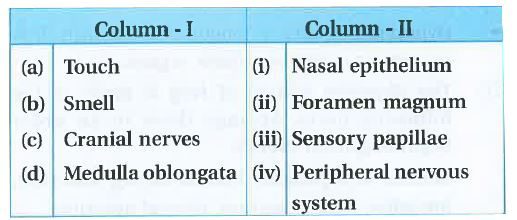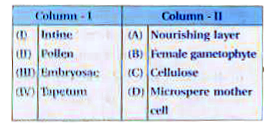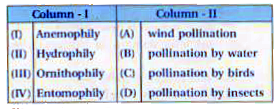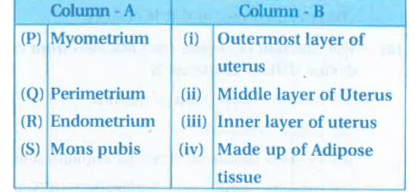கீழ்க்கண்டவற்றுள் செல்கொள்கை”பொருத்தவரையில் சரியான கூற்றைக் கண்டறி. (I) அனைத்து உயிரினங்களும் செல்களால் ஆனவை. (II) ஏற்கனவே உள்ள செல்களிலிருந்து புதிய செல்கள் தோன்றுகின்றன. (III) சல் மரபியல் தகவல்களைக் கொண்டுள்ளது. (IV) அனைத்து வளர்சிதை மாற்ற வினைகளும் செல்லுக்குள்ளே நடைபெறுகிறது.
II, III மற்றும் IV மட்டும்
I, II மற்றும் IV மட்டும்
I, II, III மற்றும் IV
III மற்றும் IV
Step by step video, text & image solution for கீழ்க்கண்டவற்றுள் செல்கொள்கை”பொருத்தவரையில் சரியான கூற்றைக் கண்டறி. (I) அனைத்து உயிரினங்களும் செல்களால் ஆனவை. (II) ஏற்கனவே உள்ள செல்களிலிருந்து புதிய செல்கள் தோன்றுகின்றன. (III) சல் மரபியல் தகவல்களைக் கொண்டுள்ளது. (IV) அனைத்து வளர்சிதை மாற்ற வினைகளும் செல்லுக்குள்ளே நடைபெறுகிறது. by Biology experts to help you in doubts & scoring excellent marks in Class 11 exams.
Updated on:21/07/2023Topper's Solved these Questions
Similar Questions
சுவாசத்தைக் கட்டுப்படுத்துவது
View Solutionசெல் சுழற்சியின் சரியான வரிசை
View SolutionFind : (i) 932 (ii) 3225 (iii) 1634 (iv) 125−13
View Solutioni. ii. iii. iv. iv. v.
View SolutionPredict the order of reactivity of following compounds in dehydrohalogenation. a. I. II. III. IV. V. b. I. II. III. IV.
View SolutionMatch the column-
Column IColumn IIA Toxinsi. MorphineB Alkaloidsii. AbrinC Lectinsiii. VinblastinD. Drugsiv. Concanavalin A
ABCDiiiiiiiviiiiiiiviiiiviiiviiiiii
View SolutionSelect the combination that correctly marches the fungi to respective class. {:(,(1),(2),(3),(4)),((I),i,iii,iv,ii),((II),ii,iii,iv,i),((III),iii,ii,i,iv),((IV),iv,i,ii,iii):}
View Solution2, 4, 5, 7 ஆகிய அனைத்து எண்களையும் பயன்படுத்தி உருவாக்கப்படும் நான்கு இலக்க எண்களில் 10-ஆவது இடத்திலுள்ள அனைத்து எண்களின் கூடுதல்.
View Solutionபின்வரும் வகையீடுகளைப் பொருத்துக
 . சரியான பொருத்தமானது
. சரியான பொருத்தமானது
View SolutionMatch the followings and choose the correct answer.

(A) (a - iii), (b - i), (c - ii), (d - iv)
(B) (a - ii), (b - i), (c - iv), (d - iii)
(C) (a - iii), (b - iv), (c - ii), (d - i)
(D) (a - iii), (b - i), (c - iv), (d - ii)
View SolutionMatch the two columns: (A) (I-A),(II- B), (III- D), (IV- C) (B) (I-B), (II-A), (III-D), (IV - C) (C) (I- A), (II-B), (III-C), (IV- D) (D) (I- D), (II- A), (III-C), (IV-B)
View SolutionMatch the two columns:

(A) (I-C), (II-D), (III-B), (IV-A)
(B) (I-D), (II-C), (III-A), (IV-B)
(C) (I-C), (II-B),(III-D), (IV-A)
(D) (I-B),(II-D),(III-C),(IV-A)
View SolutionMatch the two columns:

(A) (I-A), (II-B), (III-C), (IV-D)
(B) (I-B), (II-A), (III-C), (IV-D)
(C) (I-A), (II-C), (III-B), (IV-D)
(D) (I-D), (II-B), (III-C), (IV-A)
View SolutionMatch Column A with Column B

(A) (P-i), (Q-ii), (R-iv), (S-iii)
(B) (P-ii), (Q-i), (R-iii), (S-iv)
(C) (P-ii), (Q-iii), (R-iv), (S-i)
(D) (P-iv), (Q-iii), (R-ii), (S-i)
View SolutionMatch the following (A) (i-P), (ii-S), (iii-R), (iv-Q) (B) (i-Q), (ii-S), (iii-P), (iv-R) (C) (i-Q), (ii-P), (iii-R), (iv-S) (D) (i-P), (ii-R), (iii-Q), (iv-S)
View SolutionPredict the order of reactivity of following compounds in dehydrohalogenation. a. I. II. III. IV. V. b. I. II. III. IV.
View Solution
